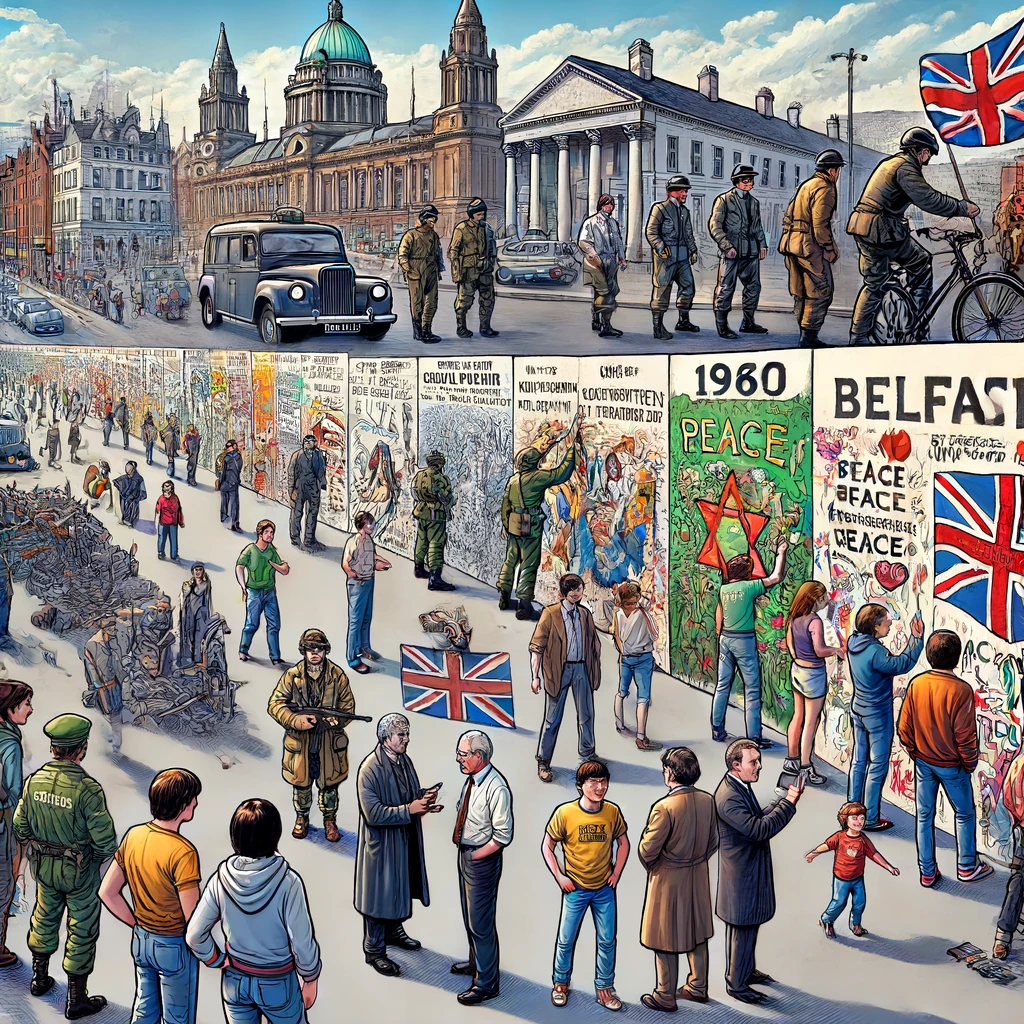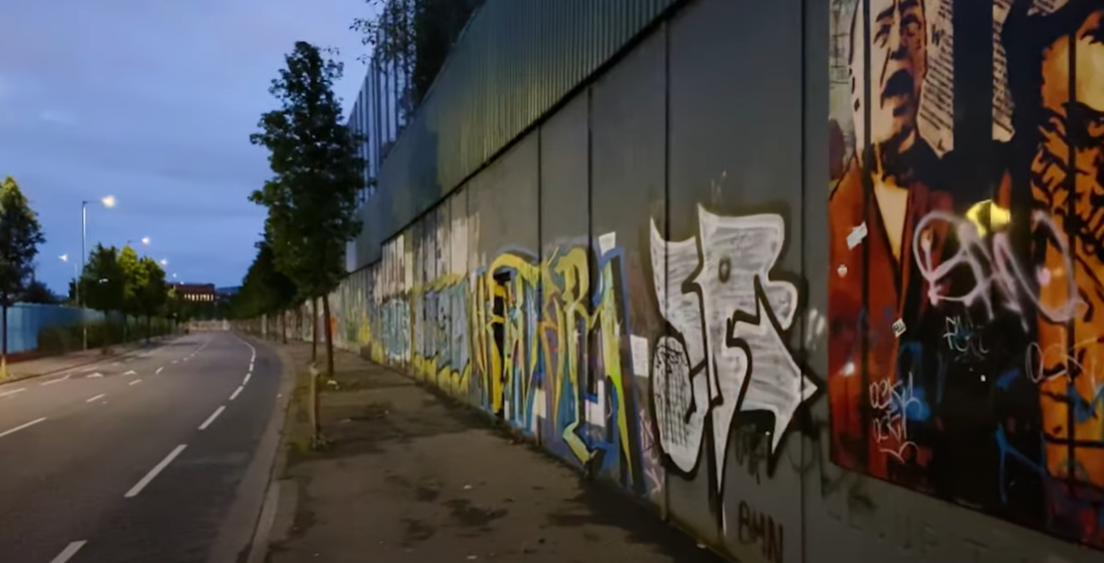The Peace Wall in Belfast stands as a symbol of the city's historical and ongoing divisions. Constructed during the height of The Troubles, it was meant to curb violence by separating nationalist and unionist neighborhoods. Stretching over 21 kilometers, it has become a poignant landmark. The wall marks past conflicts as well as reflects current hopes for peace.

Source: City Tours Belfast
I visited the Peace Wall last year and was moved by the messages written on it. Each note and drawing from visitors around the world added a unique touch of humanity. Standing there, I felt a deep sense of history intertwined with a communal desire for a peaceful future.
What is the History of the Peace Wall in Belfast?

The history of the Belfast Peace Wall begins during a period of heightened conflict. Constructed in 1969, the Peace Wall was originally intended as a temporary measure to reduce violence between the Catholic and Protestant communities in East Belfast and West Belfast. Spanning several kilometers, it now comprises multiple barriers, gates, and Belfast peace wall murals, effectively segregating parts of the community.
As the conflict in Northern Ireland, commonly known as "The Troubles," escalated, the wall grew in both size and permanence. Over the years, it has been extended and reinforced several times. The structure, made primarily of iron, steel, and concrete, stands up to 25 feet high in some sections.
Despite the 1998 Good Friday Agreement, which marked a significant decrease in hostilities, the wall remains a powerful symbol of division. Today, there are over 100 different Belfast's peace walls or interfaces across Belfast and Northern Ireland, underlining the enduring impact and complexity of the conflict.
Why Was the Belfast Peace Wall Built?
The Belfast Peace Wall was built to reduce conflict and promote safety between predominantly nationalist Catholic neighborhoods and predominantly unionist Protestant communities. Constructed in 1969, the wall emerged in response to escalating violence during a period known as The Troubles, a conflict characterized by intense, sectarian violence and strife. Stretching over 25 kilometers, this series of barriers includes walls, fences, and gates, effectively segregating parts of the city. Originally intended as a temporary measure, the structures remain because residents continue to express concerns over potential violence if they are removed.
How to Get To the Peace Wall in Belfast?
To get to the Peace Wall in Belfast, you can follow these steps:
1. Bus
Take a bus to the city center. Translink provides various routes that service the area.
From the city center, you can catch buses that travel along the Falls Road or Shankill Road, both of which run parallel to sections of the Peace Wall.
Popular bus routes include the 10, 11, and 12 services.
2. Train
Take a train to Great Victoria Street Station or Lanyon Place Station in Belfast.
From either station, you can take a short taxi ride or a local bus to the Peace Wall areas.
3. Taxi
Taxis are readily available throughout Belfast. Simply ask the driver to take you to the Peace Wall, and they will know the best routes.
Popular drop-off points include the intersection of Falls Road and Shankill Road, Cupar Way, or Lanark Way.
4. Walking
If you are already in the city center, you can walk to the Peace Wall. It is approximately a 20-30 minute walk from Belfast City Hall.
Head west along Donegall Place, continue onto Divis Street, and then onto Falls Road. The Peace Wall runs parallel to this route.
What Can You See on the Peace Wall?
On the Peace Wall in Belfast, you can witness an extensive and evolving collection of vibrant murals, graffiti, and written messages, each contributing to the rich tapestry of the city's history and aspirations for peace. Here's a more detailed look at what you can see on peace walls:
Murals
The Peace Wall is adorned with large, colorful murals created by both local and international artists. These murals often depict powerful imagery and messages that advocate for peace, unity, and understanding. They capture significant historical events and cultural pride, portraying scenes from the Troubles, the peace process, and the everyday lives of the people in Belfast. Many of these murals are intricate and detailed, reflecting the complex emotions and stories of the community.
Graffiti
Visitors from around the world leave their marks on the Peace Wall in the form of graffiti. These contributions range from simple signatures and dates to elaborate designs and heartfelt messages. The graffiti often includes expressions of hope, solidarity, and encouragement for a peaceful future. It's a way for people to connect with Belfast's history and show their support for ongoing reconciliation efforts.
Historical References
The Peace Wall serves as a canvas for artwork and writings that reflect on Belfast's troubled past. You'll find references to key events during the Troubles, a period of conflict in Northern Ireland from the late 1960s to 1998. These historical references are often accompanied by images of significant figures, symbols, and scenes that honor those who suffered and highlight the importance of the peace process.
Political Statements
The wall features over a few hundred metres a variety of political statements and symbols, representing the diverse perspectives and sentiments of the community. These messages often address the political landscape of Northern Ireland, calling for continued peace and dialogue. They provide insight into the ongoing challenges and aspirations of the people living in a post-conflict society.
Tributes
Many sections of the Peace Wall are dedicated to tributes, honoring notable figures and events associated with the peace process. These tributes recognize the efforts of individuals and groups who have worked tirelessly to keep peace lines promote reconciliation and build a better future for Northern Ireland. They serve as reminders of the progress made and the importance of continued commitment to peace.
Are there Guided Tours Available for the Belfast Peace Wall?
Yes, there are guided tours available for the Belfast Peace Wall. These tours provide in-depth historical context, insights into the political and social significance of the wall, and the opportunity to view the various murals that adorn it. Tours are typically conducted by local guides, some of whom have personal experiences and stories related to the Troubles and the peace process. Visitors can choose from walking tours, black cab tours, and bus tours, each offering a unique perspective on this important historical site.
During my visit to Belfast, I opted for a black cab tour, and it was an experience I will never forget. Our guide, a local who had lived through the Troubles, shared deeply personal stories that brought the history of the Peace Wall to life. As we drove through the city, he pointed out significant locations and explained the context behind many of the murals.
What Should Visitors Know Before Visiting Belfast Peace Wall?
Visitors planning a trip to the Peace Wall in Belfast should be well-prepared to understand both the historical and contemporary significance of this landmark. This wall, a vivid symbol of the city's past sectarian divisions, stands as a powerful reminder and an evolving canvas of political expression.
Here are several key tips to keep in mind:
-
Tour Availability: Check the availability of guided tours for insightful historical context.
-
Respect the Site: Treat the area with respect, as it represents a significant part of Belfast's history.
-
Photography: Feel free to take photos, but be mindful of the messages and artwork.
-
Interaction: Engage with the local community to hear personal stories and perspectives.
-
Safety First: Stay aware of your surroundings and follow local advice for safety.
-
Travel Preparations: Wear comfortable shoes and be prepared for variable weather conditions.
When Is the Best Time To Visit the Belfast Peace Wall?

The best time to visit the Belfast Peace Wall is during the spring and summer months, from April to September. During this period, the weather is generally mild and more conducive to outdoor activities, making it easier to explore the wall and the surrounding areas. Additionally, visiting during the daytime provides better visibility for viewing the murals and taking photographs. However, it's also advisable to check for any local events or tours that might enhance your visit experience.
During my visit to Belfast in the summer, I found the atmosphere around the Peace Wall to be vibrant and welcoming. The weather was perfect for walking, and the guided tour I joined provided fascinating insights into the history and significance of the wall. One of the highlights was seeing the incredible murals up close, each telling a unique story about the city’s past and the hope for its future. The tour guide shared personal anecdotes from the Troubles, which made the experience even more poignant.
I would highly recommend timing your visit to coincide with local festivals or cultural events. During my stay, I attended a community event that featured music, food, and discussions about Belfast’s journey towards reconciliation.
How Has the Belfast Peace Wall Affected the Social Fabric of Belfast?
The Belfast Peace Walls, initially constructed by the British Army to separate Catholic and Protestant neighborhoods during the Troubles, have significantly affected the social fabric of Belfast by physically and symbolically dividing communities. These walls, part of a series of barriers that includes several sections maintained by the Northern Irish Executive, have reinforced sectarian divisions and perpetuated a sense of mistrust between the two communities since their erection. Over time, while the walls have provided a sense of security and reduced violence, they have also hindered social integration and limited interactions between the groups. Despite these challenges, efforts toward peace and reconciliation have led to initiatives that use the walls as platforms for dialogue, understanding, and artistic expression, gradually transforming them into symbols of hope and change.
FAQs On Peace Wall Belfast
1. What is the length of the Peace wall in Belfast?
The length of the Peace Wall in Belfast is approximately 21 kilometers. This extensive structure spans various sections across different parts of the city.
2. Why was the Peace Wall in Belfast built?
The Peace Wall was built to ensure safety and prevent violence between the two conflicting communities in Belfast during the period known as The Troubles. It aimed to minimize direct confrontation and maintain relative peace in sensitive areas.
3. What is the Peace Wall in Belfast?
The Peace Wall in Belfast is a series of barriers that were originally erected to separate predominantly nationalist and unionist neighborhoods and reduce inter-communal violence. These walls, varying in length and construction, have become symbols of the city's history of political and religious divisions.
4. Can visitors write messages on the Peace Wall in Belfast?
Visitors can write messages on certain sections of the Peace Wall in Belfast. These messages often reflect hopes for peace and solidarity, turning the wall into a living canvas of visitor interactions and aspirations.
5. Are there tours available for the Peace Wall in Belfast?
Yes, guided tours are available for the Peace Wall in Belfast. These tours provide historical insights, share local perspectives, and often include visits to both sides of the wall, offering a comprehensive understanding of its significance and impact.
